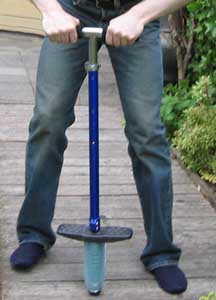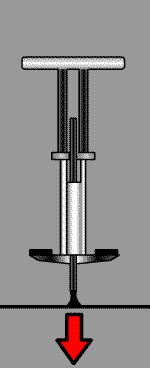User talk:Supacool124
January 2013[edit]
![]() Hello, I'm Eyesnore. I wanted to let you know that I undid one of your recent contributions, such as the one you made to Tire iron, because it didn’t appear constructive to me. If you think I made a mistake, or if you have any questions, you can leave me a message on my talk page. Thanks, Eyesnore 21:32, 22 January 2013 (UTC)
Hello, I'm Eyesnore. I wanted to let you know that I undid one of your recent contributions, such as the one you made to Tire iron, because it didn’t appear constructive to me. If you think I made a mistake, or if you have any questions, you can leave me a message on my talk page. Thanks, Eyesnore 21:32, 22 January 2013 (UTC)

Please refrain from making unconstructive edits to Wikipedia, as you did at Tire iron. Your edits appear to constitute vandalism and have been automatically reverted.
- If you would like to experiment, please use the sandbox. Note that human editors do monitor recent changes to Wikipedia articles, and administrators have the ability to block users from editing if they repeatedly engage in vandalism.
- ClueBot NG makes very few mistakes, but it does happen. If you believe the change you made should not have been considered as unconstructive, please read about it, report it here, remove this warning from your talk page, and then make the edit again.
- If you need help, please see our help pages, and if you can't find what you are looking for there, please feel free to place "
{{helpme}}" on your talk page and someone will drop by to help. - The following is the log entry regarding this warning: Tire iron was changed by Supacool124 (u) (t) ANN scored at 0.973534 on 2013-01-22T21:39:38+00:00 . Thank you. ClueBot NG (talk) 21:39, 22 January 2013 (UTC)

{{unblock|reason=Your reason here ~~~~}}, but you should read the guide to appealing blocks first. Toddst1 (talk) 21:42, 22 January 2013 (UTC)This unblock request has been declined due to your history of vandalism and/or disruption to this encyclopedia. However, we are willing to give you another chance provided that you can earn back the trust of the Wikipedia community. To be unblocked you need to demonstrate that you are willing and able to contribute positively to Wikipedia. You can do this by:
- Familiarizing yourself with our basic rules.
- Read our guide to improving articles
- Pick any pre-existing article you wish to improve.
- If you have trouble choosing an article to improve, see this index of articles needing improvement for ideas. Once you have decided on the article you will propose improvements to:
- Click the Edit tab at the top of that article;
- Copy the portion of the prose from that article that you will be proposing changes to. However:
• do not copy the "infobox" from the start of the article (i.e., markup like this: {{infobox name|...}});
• do not copy any image placement code (i.e., markup like this: [[File:Name.jpg|thumb|caption]]);
• do not copy the page's categories from the bottom of the page (i.e., markup like this: [[Category:Name]]);
• do not copy the stub tag (if there) from the bottom of the page (i.e., markup like this: {{Foo stub}}); - Click edit at your talk page, and paste at the bottom under a new section header (like this:
== [[Article title]] ==) the copied content but do not save yet; - Place your cursor in the edit summary box and paste there an edit summary in the following form which specifies the name of the article you copied from and links to it (this is required for mandatory copyright attribution): "Copied content from [[exact Name of Article]]; see that article's history for attribution."
- You can now save the page. However, if your edits will include citations to reliable sources (which they should), place at the end of the prose you copied this template
{{reflist-talk}}and then save.
- Now, edit that content to propose significant and well researched improvements by editing the selected portion of the article. Please note that we are not looking for basic typo corrections, or small unreferenced additions; your edits should be substantial, and reflect relevant policies.
- When you are done with your work, re-request unblocking and an administrator will review your proposed edits.
- If we (including the original blocking admin) are convinced that your proposed edits will improve Wikipedia as an encyclopedia, you will be unblocked.
If you need help while working with your proposed edits, you may add "{{Help me|your question here ~~~~}}" to your talk page. Thank you.--Jezebel'sPonyobons mots 19:39, 24 January 2013 (UTC)
being unblocked[edit]
i was told that if i want to be un blocked i would have to respond here
- For the food, see Corn dog.
This article needs additional citations for verification. (August 2008) |

A pogo stick is a device for jumping off the ground in a standing position with the aid of a spring, used as a toy or exercise equipment.
It consists of a pole with a handle at the top and footrests near the bottom, and a spring located somewhere along the pole. The spring joins two sections of the pole, which extends below the footpads.
The operator places his feet on the footpads while balancing on the pole, then jumps up or down with a bending action of the knees to add or subtract energy in the spring. When the spring is at full compression or extension, the operator is lifted by the recoil of the spring, being launched several inches or feet into the air. This process is repeated to maintain a periodic bounce.
The pogo stick can be steered by shifting one's weight off the centerline of the spring in the desired horizontal direction thus producing horizontal locomotion.
Inventors[edit]
A spring stilt utilizing compression springs on each foot was patented in 1891 [1] by George H. Herrington of Wichita, Kansas "for leaping great distances and heights". This was an antecedent of the pogo stick as well as today's Spring stilts. A German patent was registered March 1920 [2] to Max Pohlig and Ernst Gottschall in Hanover for a device they called a "spring end hopping stilt". It is thought that the beginning two letters in these men's last names is where the name Pogo comes from.
The two handle pogo stick design was patented by George B. Hansburg,[3] in 1957. Hansburg described the origins of the Pogo name colloquially in a story of a young Burmese girl with the aforementioned name whose father had created a crude version of the device so that the daughter could travel to the local temple for prayers.[4] An earlier design with a single upright vertical handle [5]patented in 1955 posed something of a risk to the user's chin. Later improvements to the pogo stick have been made, including the Vurtego,[6] Flybar,[7] BowGo,[8] and the Up Wing pogo stick,[9] which allow operators to jump much higher than with a simple coil spring pogo stick. Back flips and other tricks are now possible on some of these newer sticks, which has contributed to the growth of the new sport of stunt pogo or extreme pogo. Yet no matter what improvements or different types are made, the basic design idea of man or woman riding on a spring remains the same.
Popularity[edit]
This section possibly contains original research. (July 2010) |
The popularity of the pogostick has fluctuated over the years. There have been shows performed with pogo sticks, marriages performed on them, jumping contests held, and world records set and reset numerous times.
Pogo Stick was also the name of a device that British and Royal Australian Navy (RAN) sailors used to wash their clothes. The stick had a "T" shaped handle at the top and a cone (opening downwards) at the bottom. The conical part had holes to allow water and air through. The washing was put into a bucket (or better a clean rubbish bin), water and detergent added, and then the stick was agitated up and down. Whilst it was not easy work, it did a good job on the clothes and most sailors were young and fit anyway. They were in use in the RAN until at least the late 70s.
pogo sticks rumor[edit]
As legend has it, an American traveler named George Hansburg was making his way through Burma when he made the acquaintance of a poor farmer. The farmer’s daughter was named Pogo, and Pogo—devout little girl that she was—wanted to go to temple every day to pray, but couldn’t because she had no shoes to wear for the long walk through the mud and rocks. So the poor farmer built a jumping stick for her, and Pogo’s daily temple bounce-trips through the mud and over the rocks ensued. When the impressed traveler returned home, he made a jumping stick of his own, attaching a spring to the wooden stick contraption that the farmer had introduced him to.
Sure it’s far-fetched, but it’s nice, isn’t it? Wherever the idea for the jumping stick really came from, Hansburg patented his “Pogo Stick” in 1919. The Gimble Brothers Department Store in the U.S. imported a boatload of them, but unfortunately, the sticks rotted on the wet ship ride over. The folks at Gimble asked Hansburg to produce something more resilient, and Hansburg eventually did just that—from his own factory called SBI Enterprises. And those sticks, called “Master Pogos,” were the bouncing wonders that we know and love today.

See also[edit]
- Commander Keen
- Pogo (dance)
- Pogo oscillation, a dangerous oscillation produced by rocket engines
- Powerbocking
- Space hopper, another kind of bouncing toy
References[edit]
- ^ google.com/patents
- ^ depatisnet.dpma.de
- ^ google.com/patents/
- ^ Goodson, M. & Todman, B. (Producers). (1959). What's My Line [Television series]. Manhattan, New York City: CBS Broadcast Center. youtube.com. Retrieved 2011-01-19.
- ^ google.com/patents
- ^ vurtegopogostick.com
- ^ flybar.com
- ^ The Bowgo Project
- ^ alibaba.com
External links[edit]
- Oscillations of a Pogo stick, Wolfram Demonstrations Project.
- chronogram.com, Pogo Sticks in the Press
- pogostickusa.com, History of Pogo Sticks
